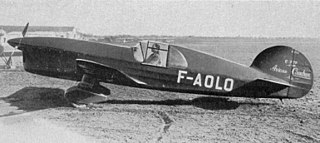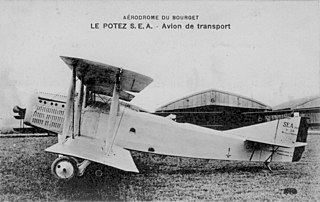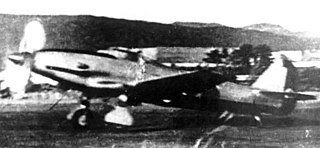Related Research Articles

The Hispano-Suiza 12Y was an aircraft engine produced by Hispano-Suiza for the French Air Force before the Second World War. The 12Y became the primary French 1,000 hp (750 kW) class engine and was used in a number of famous aircraft, including the Morane-Saulnier M.S.406 and Dewoitine D.520.

The C.710 were a series of light fighter aircraft developed by Caudron-Renault for the French Air Force just prior to the start of World War II. One version, the C.714, saw limited production, and were assigned to Polish pilots flying in France after the fall of Poland in 1939. A small number was also supplied to Finland.

The SEA IV was a French two-seat military aircraft of World War I and the immediate post-war era.

The Kawasaki Ki-45 Toryu was a two-seat, twin-engine heavy fighter used by the Imperial Japanese Army in World War II. The army gave it the designation "Type 2 Two-Seat Fighter"; the Allied reporting name was "Nick". Originally serving as a long-range escort-fighter, the design — as with most heavy fighters of the period — fell prey to smaller, lighter, more agile single-engine fighters. As such, the Ki-45 instead served as a day and nighttime interceptor and strike-fighter.

The Potez 630 and its derivatives were a family of twin-engined, multirole aircraft developed for the French Air Force in the late 1930s. The design was a contemporary of the British Bristol Blenheim and the German Messerschmitt Bf 110.
The Bréguet 690 and its derivatives were a series of light twin-engine ground-attack aircraft that were used by the French Air Force in World War II.

The Curtiss XA-14 was a 1930s United States airplane, the first multi-engine attack aircraft tested by the United States Army Air Corps. Carrying a crew of two, it was as fast as the standard pursuit aircraft in service at the time.

Potez 25 was a French twin-seat, single-engine biplane designed during the 1920s. A multi-purpose fighter-bomber, it was designed as a line aircraft and used in a variety of roles, including fighter and escort missions, tactical bombing and reconnaissance missions. In the late 1920s and early 1930s, Potez 25 was the standard multi-purpose aircraft of over 20 air forces, including French and Polish. It was also popular among private operators, notably mail transport companies.

The Morane-Saulnier M.S.225 was a French fighter aircraft of the 1930s. It was produced in limited quantities to be used as a transitional aircraft between the last of the biplanes and the first monoplane fighters.
The Potez XV was a French single-engine, two-seat observation biplane designed as a private venture by Louis Coroller and built by Potez and under licence in Poland.

The Loire 210 was a French single-seat catapult-launched fighter seaplane designed and built by Loire Aviation for the French Navy.

The Levasseur PL.5 was a carrier-based fighter produced in France in the late 1920s, in response to the 1924 AMBC.2 specification issued by the Service Technique de l'Aéronautique (STAé). It was a conventional, single-bay sesquiplane that carried a crew of two in tandem, open cockpits. Like other Levasseur naval designs of the day, it incorporated several safety features in case of ditching at sea. Apart from small floats attached directly to the undersides of the lower wing, the main units of the fixed, tail-skid undercarriage could be jettisoned in flight, and the underside of the fuselage was given a boat-like shape and made watertight.

The Villiers II was a French two-seat fighter aircraft of the 1920s intended for operation from the Aircraft carrier Béarn of the French Navy. It was a single-engined tractor biplane with a waterproof hull in the form of a flying boat to allow the aircraft to be safely landed on water in an emergency. Two prototypes and 30 production aircraft were built, the type serving briefly with the French Navy, although never operated from an aircraft carrier.

The Kawasaki Ki-64 was a one-off prototype of an experimental heavy, single seat, fighter. It had two unusual design features. First; it had two Kawasaki Ha-40 engines in tandem; one in the aircraft nose, the other behind the cockpit, both being connected by a drive shaft. This combination drove two, three-bladed, contra-rotating propellers. The second feature was the use of the wing surface as a radiator for the water-cooled engines. The aircraft first flew in December 1943. During the fifth flight, the rear engine caught fire; and while the aircraft made an emergency landing, it was damaged. The aircraft was subsequently abandoned in mid-1944 in favour of more promising projects. The airframe survived the war, and parts of the unique cooling system were sent to Wright Field for examination.

The Romano R.90 was a prototype single-seat French floatplane fighter of the 1930s. A single example of the R.90 was built, but the type did form the basis of the Romano R.83 and Romano R.92 fighters which were built in secret for the Spanish Republicans during the Spanish Civil War.

The Loire 30 a.k.a.Loire 300 was a French three-seat night reconnaissance monoplane designed and built by Loire Aviation of St. Nazaire.

The SNCAC NC-600 was a prototype French twin-engined long-range fighter aircraft, developed by SNCAC from the earlier Hanriot H.220 fighter. The type never entered service, with development being ended by the French surrender in June 1940.
The Potez 230 was a French lightweight single-seat, single-engined fighter aircraft. One prototype was built and flew in 1940, but no production followed, with the prototype being captured and shipped to Germany for study.
The Dewoitine D.720 T3 was a French reconnaissance/cooperation aircraft built by Dewoitine in the late 1930s.

The Renault 12R was an air-cooled inverted V12 aircraft engine developed by the French engineering company Renault in the 1930s. The design was based on mounting two 6Q six-cylinder engines on a single crankshaft. In production, the engine was rated between 450 and 500 hp, although a high performance version built for the sole Caudron C.712 racing special produced 730 hp (540 kW). More than one third of production went to power the Caudron C.714 light fighter that fought in the early stages of World War II for the French and Polish Air Forces.
References
- ↑ Danel 1967 , p. 4
- 1 2 3 Green & Swanborough 1994 , p. 503
- ↑ Danel 1967 , pp. 4–5
- ↑ Parmentier, Bruno (4 January 1997). "Romano R-110". Aviafrance (in French). Paris. Retrieved 2 March 2019.
- Danel, Raymond (1967). Number 195: The Potez 63 Series. Leatherhead, UK: Profile Publications. OCLC 837752040.
- Green, William; Swanborough, Gordon (1994). The Complete Book of Fighters. New York: Smithmark Publishers. ISBN 0-8317-3939-8.